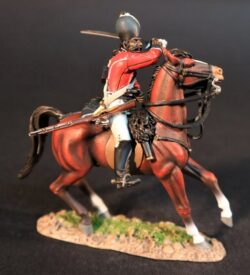WIN74-11 Two Line Infantry, 74th (Highland) Regiment of Foot
$90.00
Description
The regiment was raised in Glasgow by Major-General Sir Archibald Campbell for service in India in October 1787. In accordance with the Declaratory Act 1788 the cost of raising the regiment was recharged to the East India Company on the basis that the act required that expenses “should be defrayed out of the revenues” arising there.
The regiment embarked for India in February 1789 and took part in the Siege of Bangalore in February 1791 and the Siege of Seringapatam in February 1792 during the Third Anglo-Mysore War.
At the Battle of Assaye in 1803 casualties were so high, every officer in the regiment was killed or wounded and what was left of the unit had to be led out of action by its regimental sergeant major. From an initial strength of about 500, the 74th lost ten officers killed and seven wounded, and 124 other ranks killed and 270 wounded.
The predominant arm in India was the infantry. The King’s and EIC native battalions were organized on similar lines, with the only difference being that the EIC battalions had 2 Grenadier companies and no light company, as it was believed that the native Indian soldier was considered a poor skirmisher.
The 74th (Highland) Regiment of Foot wore kilts and plaids of Government tartan from the time they were raised in 1787. However, they were soon ordered to India, where the regiment spent 18 years. On arrival at Madras the kilt was discontinued as unsuitable. In 1803 the soldiers wore linen white trousers and black round hats.
The regiment remained on home service until 1810, when it was sent to the Peninsular War (1808-1814) for four years.
It fought at Busaco in 1810, Fuentes de Onoro in 1811, Ciudad Rodrigo, Badajoz, Salamanca in 1812, Vitoria, Nivelle, Orthes and Toulouse.
The Regiment saw service in Ireland at the time of Waterloo in 1815, and spent most of the following three decades in Canada and the West Indies.
In 1851, it arrived in the Cape Colony (in what is now South Africa) for the Eighth Cape Frontier War (1850-1853).
The troopship “Birkenhead” foundered off the coast of Southern Africa, the largest draft of new troops on board was intended for the 74th foot. Their discipline on deck as the vessel sank, later known as the “Birkenhead Drill”, allowed the women and children on board to be saved.
The Regiment was to return to India in 1854, remaining there for ten years and fighting in the Indian Mutiny (1857-59).






